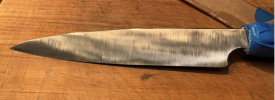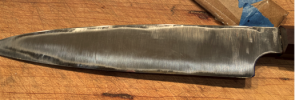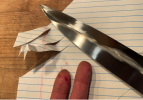Cushing H.
Gold Member
- Joined
- Jun 3, 2019
- Messages
- 2,714
I thought I would break this specific discussion out into its own thread....
Re. that Yanagiba I am finishing up .... I am finding working on the initial sharpening of it, specifically the Urasuki side, to be very enlightening in terms of how well the Ura has so far been developed. The stone marks make it VERY clear just how far the Ura has been developed towards the spine and the edge. Refer to the below photos....
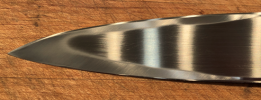

The first photo is at the tip ... and pretty clearly shows the Ura could have been carried forward further towards the tip (I seem to recall having some difficulty controlling the blade while grinding out there...). I can live with this, BUT the second photo is a close up of the edge further along towards the heel (the edge is on the bottom of the photo). It pretty clearly shows that the URA was not carried all the way to the edge.
The question is .... what do I do from here??? The work I have done so far has been with a 1000 grit waterstone .... and while I could probably continue to plug away at this and get that "sharpened" flat (I guess technically called the "Uraoshi" moved all the way down to the edge itself (which is where it must get to), but with a 64 rockwell blade and 1000 grit stone, that will take quite a while, and will also likely take several re-flattenings of the stone.
Other options I can think of would be to back off to a coarser diamond stone until I have the flat extended out to the edge .... but dont have the experience to understand whether this will produce too long a "flat" on the sharpened URA side (I have no idea just how wide the Uraoshi should be, especially along the edge..... The other option I can think of is to go back to the grinder and work to extend the width of the URA closer to the edge .... but that comes with some risk of over cutting and damaging the profile......
I have never had hands-on on any knife with a Ura .... so I just cant judge the best path forward. Those of you who have worked with this type of blade .... what do you think??
For reference, here is an image of what these blades look like in cross section. It makes it really clear what role the Ura plays in establishing the very shallow edge angle when you sharpen with the Ura side held totally flat against the sharpening stone, and why these blades can be made so darned sharp......
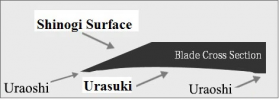
Re. that Yanagiba I am finishing up .... I am finding working on the initial sharpening of it, specifically the Urasuki side, to be very enlightening in terms of how well the Ura has so far been developed. The stone marks make it VERY clear just how far the Ura has been developed towards the spine and the edge. Refer to the below photos....


The first photo is at the tip ... and pretty clearly shows the Ura could have been carried forward further towards the tip (I seem to recall having some difficulty controlling the blade while grinding out there...). I can live with this, BUT the second photo is a close up of the edge further along towards the heel (the edge is on the bottom of the photo). It pretty clearly shows that the URA was not carried all the way to the edge.
The question is .... what do I do from here??? The work I have done so far has been with a 1000 grit waterstone .... and while I could probably continue to plug away at this and get that "sharpened" flat (I guess technically called the "Uraoshi" moved all the way down to the edge itself (which is where it must get to), but with a 64 rockwell blade and 1000 grit stone, that will take quite a while, and will also likely take several re-flattenings of the stone.
Other options I can think of would be to back off to a coarser diamond stone until I have the flat extended out to the edge .... but dont have the experience to understand whether this will produce too long a "flat" on the sharpened URA side (I have no idea just how wide the Uraoshi should be, especially along the edge..... The other option I can think of is to go back to the grinder and work to extend the width of the URA closer to the edge .... but that comes with some risk of over cutting and damaging the profile......
I have never had hands-on on any knife with a Ura .... so I just cant judge the best path forward. Those of you who have worked with this type of blade .... what do you think??
For reference, here is an image of what these blades look like in cross section. It makes it really clear what role the Ura plays in establishing the very shallow edge angle when you sharpen with the Ura side held totally flat against the sharpening stone, and why these blades can be made so darned sharp......




